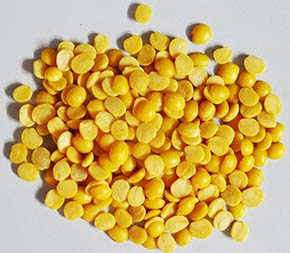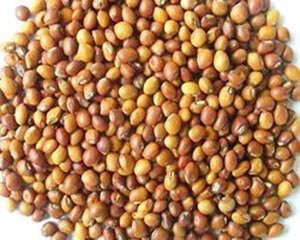Pigeon peas (Red gram) Nutrition facts
Pigeon peas are small, round to oval, mostly cherry-red colored dicotyledon seeds in the legume family. However, they come in other color patterns as yellow, brown, variegated, etc. Pigeon peas are thought to have originated in India where they are recognized as red grams and are currently grown as a major pulse crop throughout the tropics and subtropics of Asia, and sub-Saharan Africa for their nutritious dry seeds.
Botanically, the seeds of pigeon pea belong to the Fabaceae family in the Genus: Cajanus.
Scientific name: Cajanus cajan (L.) Millsp.
 |
| Pigeon peas (red gram), split. |
The pigeon pea is a drought-tolerant, perennial, but mostly cultivated as an annual, erect shrub. It grows well in a wide range of soil types, varying from sandy to heavy loams. Small, rust-brown to yellow flowers appear in racemes, which develop into elongated fruit pods, enclosing 2 to 8 seeds separated from each other in the pod by slight depressions.
The pods, like in other legumes, open along a seam on either side. Raw green seeds are ovoid, measure 6-8 mm across and turn brown, red, patterned-black as they dry depending on the cultivar type.
 |
| Pigeon peas, dry. |
Health benefits of Pigeon peas
As in other beans and peas, pigeon peas too are an excellent source of vegetarian protein. 100 grams of dry seeds contain 343 calories, and 21.70 g or 39% of recommended daily values of protein.
These peas contain good amounts of dietary fiber; provide 15 g or 39% of fiber per 100 grams. Dietary fiber works as a bulk laxative, which thereby protects the colon mucosa by decreasing its exposure time to toxic substances as well as by binding to cancer-causing chemicals in the colon.
Dietary fiber has been shown to reduce blood cholesterol levels by bringing down the reabsorption of cholesterol-binding bile acids in the colon.
Total isoflavone antioxidants in red gram peas is 0.58 mg. Isoflavones have been found to reduce post-menopausal cancers and osteoporosis.
Pigeion peas are gluten-free food items. They particularly preferred as gluten-free food alternatives in gluten-allergy and celiac disease patients.
They compose good amounts of B-complex vitamins like folates, thiamin, pyridoxine, pantothenic acid, riboflavin and niacin. Most of these vitamins work as co-factors for the enzymes in carbohydrate, protein, and fat metabolism.
Dry seeds carry 456 μg or 114% of daily required value folate. Raw, green pigeonpeas contain 173 μg of folates.
Folate, together with vitamin B-12, is one of the essential co-factor for DNA synthesis and cell division. Adequate folate in the diet around conception and during pregnancy may help prevent neural tube defects in the babies.
While raw green pigeonpeas hold 39 mg or 65% of DV of vitamin-C, dry peas do not contain any of this vitamin.
Vitamin-C is a water-soluble antioxidant that helps in boosting immunity, and fight against the oxygen-induced free radicals in the human body.
Furthermore, they are incredible sources of several essential minerals. 100 g of dry pigeonpeas hold copper-117%, iron-65%, manganese-78%, phosphorus-52%, selenium-15%, calcium-13%, and zinc-25%.
Both copper and iron take part in the production of blood cells in the human body.
Moreover, they are also very good sources of potassium. 100 grams hold, 1392 mg or 30%. Potassium is present inside cells and body fluids, which counters the pressing effects of sodium on the heart and thereby decreases blood pressure.
| Principle | Nutrient Value | Percent of RDA |
|---|---|---|
| Energy | 343 Kcal | 17% |
| Carbohydrates | 62.78 g | 48% |
| Protein | 21.70 g | 39% |
| Total Fat | 1.49 g | 7.5% |
| Cholesterol | 0 mg | 0% |
| Dietary Fiber | 15 g | 39% |
| Vitamins | ||
| Folates | 456 μg | 114% |
| Niacin | 2.965 mg | 18.5% |
| Pyridoxine | 0.283 mg | 22% |
| Riboflavin | 0.187 mg | 14% |
| Thiamin | 0.643 mg | 54% |
| Vitamin-C | 0 mg | 0% |
| Electrolytes | ||
| Sodium | 17 mg | 1% |
| Potassium | 1392 mg | 30% |
| Minerals | ||
| Calcium | 130 mg | 13% |
| Copper | 1.057 μg | 117% |
| Iron | 5.23 mg | 65% |
| Magnesium | 183 mg | 46% |
| Manganese | 1.791 mg | 78% |
| Phosphorus | 367 mg | 52% |
| Selenium | 8.2 μg | 15% |
| Zinc | 2.76 mg | 25% |
| Phyto-nutrients | ||
| Total isoflavones | 0.56 mg |
Selection and storage
Like in peas and some beans, raw, mature but green pigeon peas are treated as vegetables. However, whole dry or split seeds employed as pulses in many parts of Southern Asia, and Africa.
Choose cleaned, dry, whole, or split peas packed in bins or bags in grocery stores and wholesale markets. Avoid insect-damaged, broken, mold-inflicted seeds.
To store, place whole dry beans in plastic/steel containers away from moisture and heat. Whole seeds can keep well for several months if preserved in air-tight bins.
Raw, green pigeon peas can be kept in the home refrigerator for 2-3 days, and shelled peas used like vegetables. Do not deep freeze the whole pods as they sustain a chilling injury.
Preparation and serving methods
In most Indian households, split red grams are preferred over whole peas in the cooking. Soak split peas in water for 30 minutes. Whole seeds may take 4-6 hours to soak. Although soaking is not mandatory, it quickens overall cooking time, removes anti-nutritional compounds, and enriches the flavor.
Pressure cooked for 10 min with soaking; 15-20 minutes without soaking. Avoid overcooking which turns them mashed.
Red gram is used in soups and dips, or as mixed dhal.
Here are some serving tips:
Split pigeon peas (red gram or arhar/toovar dal) are one of the most sought-after pulses in Indian households. They feature in many traditional Indian dishes with seasonal vegetables, herbs, and spices.
In the southern Indian and Maharashtra states, pureed split pigeon pea paste is used as a filling in sweet stuffed bread (puran poli) recipes.
Pigeon peas are the most liked pulses in West Africa. Fiofio with taro (cocoyam) recipe is a traditional dip served with rice.
In Jamaica where they are known as gungo peas, raw green pigeon peas used in the rice-pilaf preparation.
In India and Pakistan, arahar ki dal and palalk (spit pigeon pea and spinach curry) is a popular recipe served with flatbreads/rice.
Safety profile
Unlike chickpeas and red kidney beans, pigeon peas digested easily, and may cause less intense gastritis and flatulence problems. (Medical disclaimer).
You may also like to read-≻≻-
Adzuki beans nutrition facts and health benefits.
Black gram nutrition facts and health benefits.
Chickpeas nutrition facts and health benefits.
Navy beans nutrition facts and health benefits.
≺≺-Back to Legumes from Pigeon peas. Visit here for an impressive list of vegetables with complete illustrations of their nutrition facts and health benefits.
≺≺-Back to Home page.
Further Reading:
Pigeonpea-plant guide United States Department of Agriculture.-pdf.